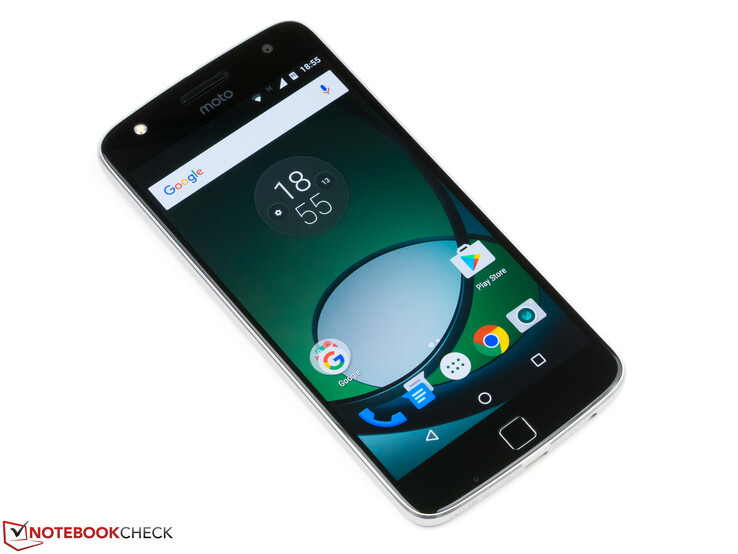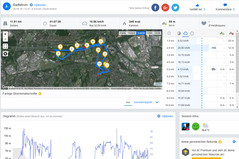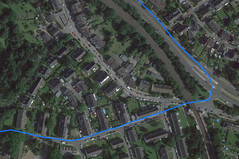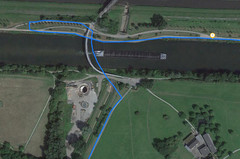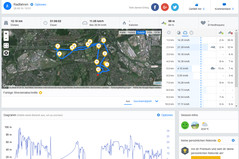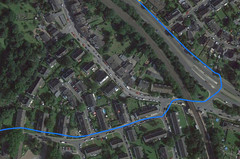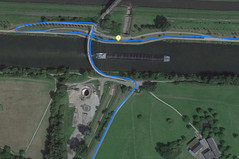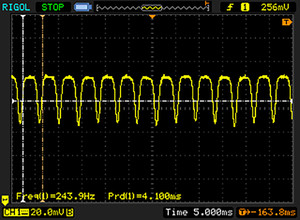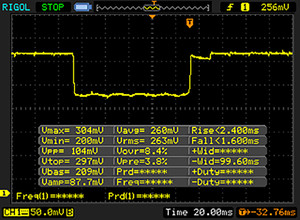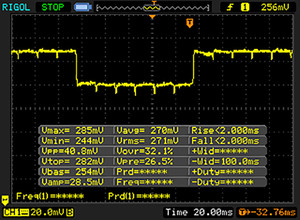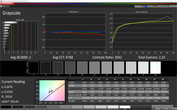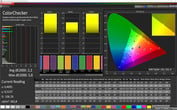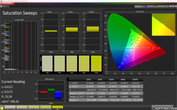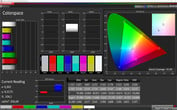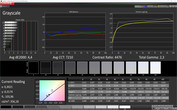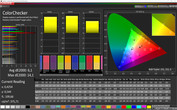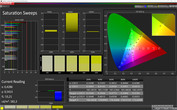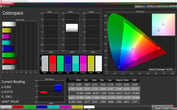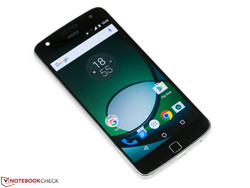Breve Análise do Smartphone Lenovo Moto Z Play
Os Top 10
» Os Top 10 Portáteis Multimídia
» Os Top 10 Portáteis de Jogos
» Os Top 10 Portáteis Leves para Jogos
» Os Top 10 Portáteis Acessíveis de Escritório/Empresariais
» Os Top 10 Portáteis Premium de Escritório/Empresariais
» Os Top 10 dos Portáteis Workstation
» Os Top 10 Subportáteis
» Os Top 10 Ultrabooks
» Os Top 10 Conversíveis
» Os Top 10 Tablets
» Os Top 10 Smartphones
» A melhores Telas de Portáteis Analisadas Pela Notebookcheck
» Top 10 dos portáteis abaixo dos 500 Euros da Notebookcheck
» Top 10 dos Portáteis abaixo dos 300 Euros
Size Comparison
| Networking | |
| iperf3 transmit AX12 | |
| Apple iPhone 7 (Klaus I211) | |
| OnePlus 3 | |
| Huawei P9 | |
| Lenovo Moto Z Play | |
| Motorola Moto X Play | |
| Asus Zenfone 3 ZE552KL | |
| iperf3 receive AX12 | |
| Apple iPhone 7 (Klaus I211) | |
| OnePlus 3 | |
| Huawei P9 | |
| Lenovo Moto Z Play | |
| Motorola Moto X Play | |
| Asus Zenfone 3 ZE552KL | |
Comparação de imagens
Escolha uma cena e navegue pela primeira imagem. Um clique muda a posição nas telas sensíveis ao toque. Um clique na imagem ampliada abre o original em uma nova janela. A primeira imagem mostra a fotografia em escala do dispositivo de teste.
Scene 1Scene 2Scene 3
| |||||||||||||||||||||||||
iluminação: 93 %
iluminação com acumulador: 509 cd/m²
Contraste: ∞:1 (Preto: 0 cd/m²)
ΔE ColorChecker Calman: 2.2 | ∀{0.5-29.43 Ø4.78}
ΔE Greyscale Calman: 2 | ∀{0.09-98 Ø5}
Gamma: 2.25
CCT: 6768 K
| Lenovo Moto Z Play AMOLED, 1920x1080, 5.5" | Samsung Galaxy A5 2016 Super AMOLED, 1920x1080, 5.2" | Sony Xperia XA IPS, 1280x720, 5" | Huawei P9 Lite IPS, 1920x1080, 5.2" | Honor 8 IPS, 1920x1080, 5.2" | OnePlus 3 Optic-AMOLED, 1920x1080, 5.5" | Lenovo Moto Z AMOLED, 2560x1440, 5.5" | |
|---|---|---|---|---|---|---|---|
| Screen | |||||||
| Brightness middle (cd/m²) | 509 | 378 -26% | 518 2% | 505 -1% | 451 -11% | 419 -18% | 485 -5% |
| Brightness (cd/m²) | 511 | 380 -26% | 475 -7% | 468 -8% | 443 -13% | 431 -16% | 490 -4% |
| Brightness Distribution (%) | 93 | 91 -2% | 81 -13% | 88 -5% | 93 0% | 84 -10% | 92 -1% |
| Black Level * (cd/m²) | 0.61 | 0.74 | 0.4 | ||||
| Colorchecker dE 2000 * | 2.2 | 1.95 11% | 6.8 -209% | 4.1 -86% | 5.4 -145% | 4.1 -86% | 2.1 5% |
| Colorchecker dE 2000 max. * | 5.8 | 3.09 47% | 11.4 -97% | 5.8 -0% | 9.9 -71% | 12 -107% | 5.5 5% |
| Greyscale dE 2000 * | 2 | 1.86 7% | 7 -250% | 4.9 -145% | 6.7 -235% | 3.3 -65% | 2.6 -30% |
| Gamma | 2.25 98% | 2.13 103% | 2.35 94% | 2.5 88% | 2.33 94% | 2.1 105% | 2.23 99% |
| CCT | 6768 96% | 6376 102% | 8151 80% | 7116 91% | 8262 79% | 6550 99% | 6843 95% |
| Contrast (:1) | 849 | 682 | 1128 | ||||
| Color Space (Percent of AdobeRGB 1998) (%) | 89.38 | 88.14 | |||||
| Color Space (Percent of sRGB) (%) | 100 | 100 |
* ... menor é melhor
Cintilação da tela / PWM (modulação por largura de pulso)
| Tela tremeluzindo/PWM detectado | 243.9 Hz | ||
A luz de fundo da tela pisca em 243.9 Hz (pior caso, por exemplo, utilizando PWM) . A frequência de 243.9 Hz é relativamente baixa, portanto, usuários sensíveis provavelmente notarão cintilação e sentirão fadiga ocular na configuração de brilho indicada e abaixo. [pwm_comparison] Em comparação: 53 % de todos os dispositivos testados não usam PWM para escurecer a tela. Se PWM foi detectado, uma média de 8118 (mínimo: 5 - máximo: 343500) Hz foi medida. | |||
Exibir tempos de resposta
| ↔ Tempo de resposta preto para branco | ||
|---|---|---|
| 4 ms ... ascensão ↗ e queda ↘ combinadas | ↗ 2.4 ms ascensão | |
| ↘ 1.6 ms queda | ||
| A tela mostra taxas de resposta muito rápidas em nossos testes e deve ser muito adequada para jogos em ritmo acelerado. Em comparação, todos os dispositivos testados variam de 0.1 (mínimo) a 240 (máximo) ms. » 15 % de todos os dispositivos são melhores. Isso significa que o tempo de resposta medido é melhor que a média de todos os dispositivos testados (20.2 ms). | ||
| ↔ Tempo de resposta 50% cinza a 80% cinza | ||
| 4 ms ... ascensão ↗ e queda ↘ combinadas | ↗ 2 ms ascensão | |
| ↘ 2 ms queda | ||
| A tela mostra taxas de resposta muito rápidas em nossos testes e deve ser muito adequada para jogos em ritmo acelerado. Em comparação, todos os dispositivos testados variam de 0.165 (mínimo) a 636 (máximo) ms. » 14 % de todos os dispositivos são melhores. Isso significa que o tempo de resposta medido é melhor que a média de todos os dispositivos testados (31.6 ms). | ||
| AnTuTu v6 - Total Score (classificar por valor) | |
| Lenovo Moto Z Play | |
| Samsung Galaxy A5 2016 | |
| Sony Xperia XA | |
| Huawei P9 Lite | |
| Honor 8 | |
| OnePlus 3 | |
| Lenovo Moto Z | |
| Geekbench 3 | |
| 32 Bit Multi-Core Score (classificar por valor) | |
| Lenovo Moto Z Play | |
| Samsung Galaxy A5 2016 | |
| 32 Bit Single-Core Score (classificar por valor) | |
| Lenovo Moto Z Play | |
| Samsung Galaxy A5 2016 | |
| 64 Bit Multi-Core Score (classificar por valor) | |
| Huawei P9 Lite | |
| OnePlus 3 | |
| Lenovo Moto Z | |
| 64 Bit Single-Core Score (classificar por valor) | |
| Huawei P9 Lite | |
| OnePlus 3 | |
| Lenovo Moto Z | |
| Geekbench 4.0 | |
| 64 Bit Multi-Core Score (classificar por valor) | |
| Lenovo Moto Z Play | |
| Honor 8 | |
| OnePlus 3 | |
| Lenovo Moto Z | |
| 64 Bit Single-Core Score (classificar por valor) | |
| Lenovo Moto Z Play | |
| Honor 8 | |
| OnePlus 3 | |
| Lenovo Moto Z | |
| Compute RenderScript Score (classificar por valor) | |
| Lenovo Moto Z Play | |
| Honor 8 | |
| OnePlus 3 | |
| Lenovo Moto Z | |
| PCMark for Android - Work performance score (classificar por valor) | |
| Lenovo Moto Z Play | |
| Samsung Galaxy A5 2016 | |
| Sony Xperia XA | |
| Huawei P9 Lite | |
| Honor 8 | |
| OnePlus 3 | |
| Lenovo Moto Z | |
| GFXBench (DX / GLBenchmark) 2.7 | |
| T-Rex Onscreen (classificar por valor) | |
| Lenovo Moto Z Play | |
| Samsung Galaxy A5 2016 | |
| Sony Xperia XA | |
| Huawei P9 Lite | |
| Honor 8 | |
| OnePlus 3 | |
| Lenovo Moto Z | |
| 1920x1080 T-Rex Offscreen (classificar por valor) | |
| Lenovo Moto Z Play | |
| Samsung Galaxy A5 2016 | |
| Sony Xperia XA | |
| Huawei P9 Lite | |
| Honor 8 | |
| OnePlus 3 | |
| Lenovo Moto Z | |
| GFXBench 3.0 | |
| 1920x1080 1080p Manhattan Offscreen (classificar por valor) | |
| Lenovo Moto Z Play | |
| Samsung Galaxy A5 2016 | |
| Sony Xperia XA | |
| Huawei P9 Lite | |
| Honor 8 | |
| OnePlus 3 | |
| Lenovo Moto Z | |
| on screen Manhattan Onscreen OGL (classificar por valor) | |
| Lenovo Moto Z Play | |
| Samsung Galaxy A5 2016 | |
| Sony Xperia XA | |
| Huawei P9 Lite | |
| Honor 8 | |
| OnePlus 3 | |
| Lenovo Moto Z | |
| GFXBench 3.1 | |
| 1920x1080 Manhattan ES 3.1 Offscreen (classificar por valor) | |
| Lenovo Moto Z Play | |
| Sony Xperia XA | |
| Huawei P9 Lite | |
| Honor 8 | |
| OnePlus 3 | |
| Lenovo Moto Z | |
| on screen Manhattan ES 3.1 Onscreen (classificar por valor) | |
| Lenovo Moto Z Play | |
| Sony Xperia XA | |
| Huawei P9 Lite | |
| Honor 8 | |
| OnePlus 3 | |
| Lenovo Moto Z | |
| 3DMark | |
| 1280x720 offscreen Ice Storm Unlimited Score (classificar por valor) | |
| Lenovo Moto Z Play | |
| Samsung Galaxy A5 2016 | |
| Sony Xperia XA | |
| Huawei P9 Lite | |
| Honor 8 | |
| OnePlus 3 | |
| Lenovo Moto Z | |
| 1280x720 offscreen Ice Storm Unlimited Graphics Score (classificar por valor) | |
| Lenovo Moto Z Play | |
| Samsung Galaxy A5 2016 | |
| Sony Xperia XA | |
| Huawei P9 Lite | |
| Honor 8 | |
| OnePlus 3 | |
| Lenovo Moto Z | |
| 1280x720 offscreen Ice Storm Unlimited Physics (classificar por valor) | |
| Lenovo Moto Z Play | |
| Samsung Galaxy A5 2016 | |
| Sony Xperia XA | |
| Huawei P9 Lite | |
| Honor 8 | |
| OnePlus 3 | |
| Lenovo Moto Z | |
| 2560x1440 Sling Shot OpenGL ES 3.0 Physics (classificar por valor) | |
| Lenovo Moto Z Play | |
| Samsung Galaxy A5 2016 | |
| Sony Xperia XA | |
| Huawei P9 Lite | |
| Honor 8 | |
| OnePlus 3 | |
| Lenovo Moto Z | |
| 2560x1440 Sling Shot OpenGL ES 3.0 Graphics (classificar por valor) | |
| Lenovo Moto Z Play | |
| Samsung Galaxy A5 2016 | |
| Sony Xperia XA | |
| Huawei P9 Lite | |
| Honor 8 | |
| OnePlus 3 | |
| Lenovo Moto Z | |
| 2560x1440 Sling Shot OpenGL ES 3.0 (classificar por valor) | |
| Lenovo Moto Z Play | |
| Samsung Galaxy A5 2016 | |
| Sony Xperia XA | |
| Huawei P9 Lite | |
| Honor 8 | |
| OnePlus 3 | |
| Lenovo Moto Z | |
| Mozilla Kraken 1.1 - Total (classificar por valor) | |
| Lenovo Moto Z Play | |
| Samsung Galaxy A5 2016 | |
| Sony Xperia XA | |
| Huawei P9 Lite | |
| Honor 8 | |
| OnePlus 3 | |
| Lenovo Moto Z | |
| Octane V2 - Total Score (classificar por valor) | |
| Lenovo Moto Z Play | |
| Samsung Galaxy A5 2016 | |
| Sony Xperia XA | |
| Huawei P9 Lite | |
| Honor 8 | |
| OnePlus 3 | |
| Lenovo Moto Z | |
| WebXPRT 2015 - Overall (classificar por valor) | |
| Lenovo Moto Z Play | |
| Samsung Galaxy A5 2016 | |
| Sony Xperia XA | |
| Huawei P9 Lite | |
| Honor 8 | |
| OnePlus 3 | |
| Lenovo Moto Z | |
| JetStream 1.1 - Total Score (classificar por valor) | |
| Lenovo Moto Z Play | |
| Samsung Galaxy A5 2016 | |
| Sony Xperia XA | |
| Huawei P9 Lite | |
| Honor 8 | |
| OnePlus 3 | |
| Lenovo Moto Z | |
* ... menor é melhor
| Lenovo Moto Z Play | Samsung Galaxy A5 2016 | Sony Xperia XA | Huawei P9 Lite | Honor 8 | OnePlus 3 | Lenovo Moto Z | |
|---|---|---|---|---|---|---|---|
| AndroBench 3-5 | -38% | -22% | -27% | -11% | 91% | 77% | |
| Random Read 4KB (MB/s) | 38.78 | 22.9 -41% | 22.05 -43% | 38.22 -1% | 34.16 -12% | 137.6 255% | 117.2 202% |
| Random Write 4KB (MB/s) | 45.58 | 11.2 -75% | 10.6 -77% | 15.35 -66% | 31.5 -31% | 18.23 -60% | 74.9 64% |
| Sequential Write 256KB (MB/s) | 73.1 | 60.4 -17% | 68.6 -6% | 46.24 -37% | 119.3 63% | 153.3 110% | 168.3 130% |
| Sequential Read 256KB (MB/s) | 254.8 | 209.4 -18% | 240.4 -6% | 283.5 11% | 247.5 -3% | 408.7 60% | 439.7 73% |
| Sequential Write 256KB SDCard (MB/s) | 50.6 | 50.7 0% | 25.1 -50% | 23.59 -53% | 45.64 -10% | ||
| Sequential Read 256KB SDCard (MB/s) | 74.6 | 72.9 -2% | 60.8 -18% | 53.7 -28% | 78.5 5% |
| Asphalt 8: Airborne | |||
| Configurações | Valor | ||
| high | 30 fps | ||
| very low | 30 fps | ||
| Dead Trigger 2 | |||
| Configurações | Valor | ||
| high | 56 fps | ||
(+) A temperatura máxima no lado superior é 34.5 °C / 94 F, em comparação com a média de 35.2 °C / 95 F , variando de 21.9 a 247 °C para a classe Smartphone.
(+) A parte inferior aquece até um máximo de 32.7 °C / 91 F, em comparação com a média de 34 °C / 93 F
(+) Em uso inativo, a temperatura média para o lado superior é 28.5 °C / 83 F, em comparação com a média do dispositivo de 32.9 °C / ### class_avg_f### F.
Lenovo Moto Z Play análise de áudio
(+) | os alto-falantes podem tocar relativamente alto (###valor### dB)
Graves 100 - 315Hz
(-) | quase nenhum baixo - em média 28.9% menor que a mediana
(±) | a linearidade dos graves é média (8.3% delta para a frequência anterior)
Médios 400 - 2.000 Hz
(±) | médios reduzidos - em média 5.2% menor que a mediana
(+) | médios são lineares (4.7% delta para frequência anterior)
Altos 2 - 16 kHz
(+) | agudos equilibrados - apenas 1.9% longe da mediana
(+) | os máximos são lineares (1.4% delta da frequência anterior)
Geral 100 - 16.000 Hz
(±) | a linearidade do som geral é média (17.9% diferença em relação à mediana)
Comparado com a mesma classe
» 15% de todos os dispositivos testados nesta classe foram melhores, 8% semelhantes, 77% piores
» O melhor teve um delta de 11%, a média foi 35%, o pior foi 134%
Comparado com todos os dispositivos testados
» 36% de todos os dispositivos testados foram melhores, 8% semelhantes, 56% piores
» O melhor teve um delta de 4%, a média foi 24%, o pior foi 134%
no name análise de áudio
(+) | os alto-falantes podem tocar relativamente alto (###valor### dB)
Graves 100 - 315Hz
(±) | graves reduzidos - em média 11.6% menor que a mediana
(±) | a linearidade dos graves é média (7.4% delta para a frequência anterior)
Médios 400 - 2.000 Hz
(+) | médios equilibrados - apenas 2.7% longe da mediana
(+) | médios são lineares (2.6% delta para frequência anterior)
Altos 2 - 16 kHz
(+) | agudos equilibrados - apenas 2.4% longe da mediana
(+) | os máximos são lineares (3.8% delta da frequência anterior)
Geral 100 - 16.000 Hz
(+) | o som geral é linear (10.5% diferença em relação à mediana)
Comparado com a mesma classe
» 5% de todos os dispositivos testados nesta classe foram melhores, 1% semelhantes, 94% piores
» O melhor teve um delta de 4%, a média foi 24%, o pior foi 134%
Comparado com todos os dispositivos testados
» 5% de todos os dispositivos testados foram melhores, 1% semelhantes, 94% piores
» O melhor teve um delta de 4%, a média foi 24%, o pior foi 134%
Lenovo Moto Z análise de áudio
(+) | os alto-falantes podem tocar relativamente alto (###valor### dB)
Graves 100 - 315Hz
(-) | quase nenhum baixo - em média 34.4% menor que a mediana
(±) | a linearidade dos graves é média (8.2% delta para a frequência anterior)
Médios 400 - 2.000 Hz
(±) | médios reduzidos - em média 5.4% menor que a mediana
(+) | médios são lineares (6% delta para frequência anterior)
Altos 2 - 16 kHz
(+) | agudos equilibrados - apenas 2.3% longe da mediana
(+) | os máximos são lineares (1.8% delta da frequência anterior)
Geral 100 - 16.000 Hz
(±) | a linearidade do som geral é média (23.5% diferença em relação à mediana)
Comparado com a mesma classe
» 53% de todos os dispositivos testados nesta classe foram melhores, 8% semelhantes, 39% piores
» O melhor teve um delta de 11%, a média foi 35%, o pior foi 134%
Comparado com todos os dispositivos testados
» 69% de todos os dispositivos testados foram melhores, 6% semelhantes, 24% piores
» O melhor teve um delta de 4%, a média foi 24%, o pior foi 134%
| desligado | |
| Ocioso | |
| Carga |
|
Key:
min: | |
| Lenovo Moto Z Play 3510 mAh | Samsung Galaxy A5 2016 2900 mAh | Sony Xperia XA 2300 mAh | Huawei P9 Lite 3000 mAh | Honor 8 3000 mAh | OnePlus 3 3000 mAh | Lenovo Moto Z 2600 mAh | |
|---|---|---|---|---|---|---|---|
| Power Consumption | -74% | -69% | -98% | -108% | -104% | -62% | |
| Idle Minimum * (Watt) | 0.51 | 0.96 -88% | 0.72 -41% | 0.73 -43% | 0.78 -53% | 0.57 -12% | 0.66 -29% |
| Idle Average * (Watt) | 0.87 | 1.64 -89% | 1.5 -72% | 2.09 -140% | 1.89 -117% | 1.24 -43% | 1.01 -16% |
| Idle Maximum * (Watt) | 0.9 | 1.71 -90% | 1.57 -74% | 2.11 -134% | 2.02 -124% | 1.36 -51% | 1.09 -21% |
| Load Average * (Watt) | 1.69 | 2.98 -76% | 3.48 -106% | 4.15 -146% | 5.28 -212% | 5.92 -250% | 3.97 -135% |
| Load Maximum * (Watt) | 4 | 5.08 -27% | 6.04 -51% | 5.05 -26% | 5.44 -36% | 10.53 -163% | 8.34 -109% |
* ... menor é melhor
| Lenovo Moto Z Play 3510 mAh | Samsung Galaxy A5 2016 2900 mAh | Sony Xperia XA 2300 mAh | Huawei P9 Lite 3000 mAh | Honor 8 3000 mAh | OnePlus 3 3000 mAh | Lenovo Moto Z 2600 mAh | |
|---|---|---|---|---|---|---|---|
| Duração da bateria | -26% | -66% | -46% | -49% | -33% | -47% | |
| Reader / Idle (h) | 42.3 | 38.7 -9% | 12.9 -70% | 23.4 -45% | 24.8 -41% | 22.3 -47% | 22.9 -46% |
| H.264 (h) | 19.8 | 11.2 -43% | 7.7 -61% | 9.5 -52% | 8.8 -56% | 14.1 -29% | 12.1 -39% |
| WiFi v1.3 (h) | 13.7 | 10.4 -24% | 5.9 -57% | 10.1 -26% | 8.3 -39% | 14 2% | 6.8 -50% |
| Load (h) | 10.9 | 8.1 -26% | 2.8 -74% | 4.5 -59% | 4.3 -61% | 4.5 -59% | 5.3 -51% |
Pro
Contra
Como com o Moto Z, um dos recursos principais do Moto Z Play é sua expansibilidade via Moto Mods. De acordo com a Lenovo, esses módulos serão suportados por, pelo menos, três gerações de aparelhos. No entanto, primeiro os compradores terão que procurar mais profundo em seus bolsos. Embora isto possa ser considerado sem sentido, recomenda-se dar uma olhada no Moto Z Play: Com o seu SoC Snapdragon 625 energeticamente eficiente e suficientemente veloz, a tela convence com altos contrastes e boa estabilidade dos ângulos de visão, e a carcaça feita de uma composição de metal-vidro que se sente de primeira categoria. Além disso, o modelo de teste oferece quase tudo que os compradores de smartphone desejam com funcionalidade dual-SIM, NFC, porta USB Type-C, e veloz leitor de digitais - inclusive um conector de 3,5-mm está integrado. Uma das verdadeiras desvantagens do modelo de teste é pouco confiável auto-foco da câmera principal.
Em vista da grande diferença do preço de mais de 200 Euros (~$222) entre o Moto Z e Moto Z Play, as pequenas deficiências do modelo mais econômico, em alguns aspectos, são surpreendentes. Os compradores que podem dispensar á última gota de nitidez da tela, um design extremamente fino, e altas reservas de poder em favor de quase o dobro da duração da bateria, estarão bem cobertos com o Moto Z Play.
Uma alternativa interessante baseada em um SoC Snapdragon 625 seria o Asus ZenFone 3. A construção do aparelho é de alta qualidade e vem com um extenso pacote de software de fábrica. No entanto, à diferença do Moto Z Play, não possui NFC ou expansibilidade modular. Os compradores que desejem o poder de gama alta com um preço de gama média ficarão curiosos por nossa análise do ZTE Axon 7 que chegará em breve.
Lenovo Moto Z Play
- 10/27/2016 v5.1 (old)
Andreas Kilian




